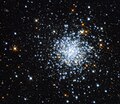Dosiero:NGC2164 - HST - Potw2134a.jpg

Grandeco de ĉi antaŭvido: 689 × 600 rastrumeroj. Aliaj distingivoj: 276 × 240 rastrumeroj | 552 × 480 rastrumeroj | 883 × 768 rastrumeroj | 1 177 × 1 024 rastrumeroj | 2 354 × 2 048 rastrumeroj | 3 759 × 3 271 rastrumeroj.
Bildo en pli alta difino ((3 759 × 3 271 rastrumeroj, grandeco de dosiero: 4,58 MB, MIME-tipo: image/jpeg))
Dosierhistorio
Alklaku iun daton kaj horon por vidi kiel la dosiero tiam aspektis.
| Dato/Horo | Bildeto | Grandecoj | Uzanto | Komento | |
|---|---|---|---|---|---|
| nun | 06:32, 23 aŭg. 2021 |  | 3 759 × 3 271 (4,58 MB) | Fabian RRRR | == {{int:filedesc}} == {{Information |description={{en|1='''Cluster in the Cloud This Picture of the Week shows an open cluster known as NGC 2164, which was first discovered in 1826 by a Scottish astronomer named James Dunlop. NGC 2164 is located within one of the Milky Way galaxy's closest neighbours — the satellite galaxy known as the Large Magellanic Cloud. The Large Magellanic cloud is a relatively small galaxy that lies about 160 000 light-years from Earth. It is considered a satellite... |
Dosiera uzado
La jena paĝo ligas al ĉi tiu dosiero:
Suma uzado de la dosiero
La jenaj aliaj vikioj utiligas ĉi tiun dosieron:
- Uzado en ar.wikipedia.org
- Uzado en az.wikipedia.org
- Uzado en be.wikipedia.org
- Uzado en bs.wikipedia.org
- Uzado en ce.wikipedia.org
- Uzado en de.wikipedia.org
- Uzado en diq.wikipedia.org
- Uzado en el.wikipedia.org
- Uzado en en.wikipedia.org
- Uzado en eu.wikipedia.org
- Uzado en fr.wikipedia.org
- Uzado en hr.wikipedia.org
- Uzado en kk.wikipedia.org
- Uzado en mk.wikipedia.org
- Uzado en nl.wikipedia.org
- Uzado en pl.wikipedia.org
- Uzado en pt.wikipedia.org
- Uzado en ru.wikipedia.org
- Uzado en sh.wikipedia.org
- Uzado en sk.wikipedia.org
- Uzado en sr.wikipedia.org
- Uzado en tl.wikipedia.org
- Uzado en tr.wikipedia.org
- Uzado en tt.wikipedia.org
- Uzado en uk.wikipedia.org
- Uzado en uz.wikipedia.org
- Uzado en vi.wikipedia.org
- Uzado en www.wikidata.org
- Uzado en zh.wikipedia.org